A question we often are asked is, “Where will you be on (pick your date here)?” Our answer is usually, “We aren’t even sure where we will be tomorrow”. It’s hard for those who live by a normal schedule, with set vacations or holidays to understand this unpredictable life we lead. We, however, have become so used to a constant change in plans due to maintenance, weather, or just plain whim, that we can hardly imagine living any other way. Our time in the Florida Keys was just another example of our plans changing day by day to fit whatever worked best for us at the time.
The lunar eclipse, January 21, 2018
The night before we left Marco Island to head farther south towards the Keys was the night of the total lunar eclipse and I wasn’t about to miss that event. I wasn’t sure I’d capture much on my camera, as it was cold and windy outside. Although one more dedicated might have camped out on the dock with a tripod at hand, I am a warmth lover, and I wasn’t willing to leave the comfort of my boat for very long. Therefore, every 15 minutes from the time the eclipse started I ducked out to take a few shots of the main event. It had been a cloudy night, but luckily, there always seemed to be a break between the clouds during my ventures outside. After the full eclipse happened at 11:45 the clouds filled in and I felt justified in going to bed and saying I did my best. It was a lovely sight to see.
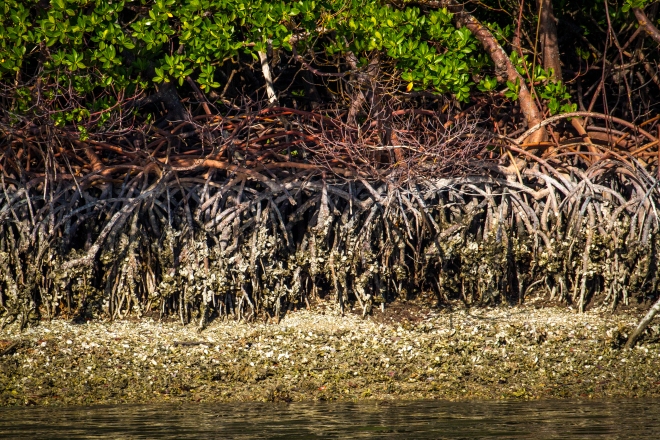 The tangled roots of the Everglades National Park mangroves
The tangled roots of the Everglades National Park mangroves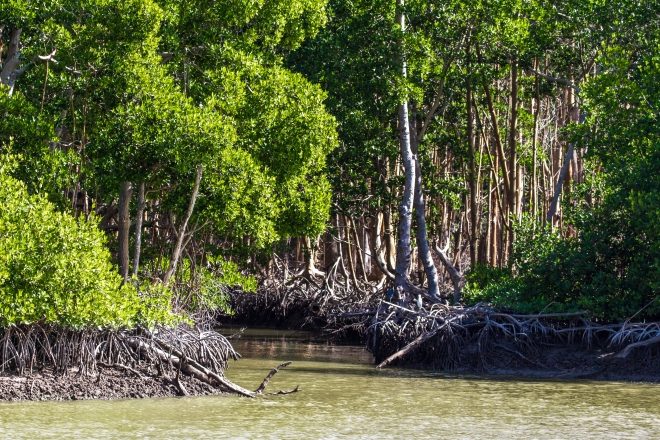
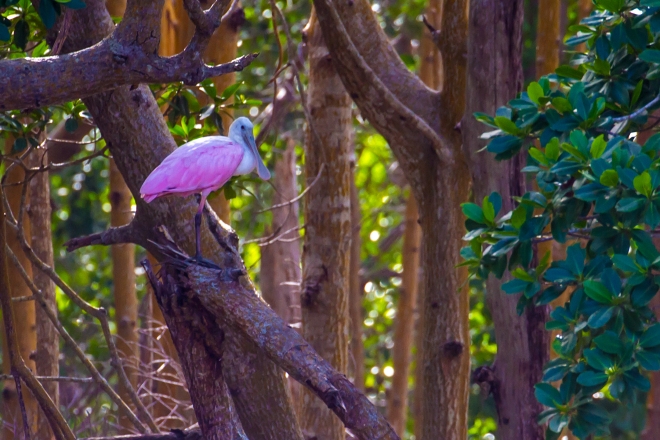 A roseate spoonbill in the Everglades
A roseate spoonbill in the Everglades
After a nice trip south, we anchored for the next two nights in Everglades National Park. Previously our trips to the Everglades were by car or by airplane and brought us to the land of tall grasses, swamps, and lots of alligators. This trip was different, however. Here, on the rivers that empty into the Gulf of Mexico, the landscape was filled with mangroves and gumbo limbo trees. In fact, the trees were so tightly packed that it is inconceivable that a person could walk through the veritable jungle. Mangroves are important to the Everglades because their roots stabilize the coastline as they provide protection from wind and waves. The trees themselves provide the perfect habitat for the wildlife that live in the area; Everglades National Park has the largest stand of protected mangroves in this hemisphere.
 The Seven-Mile Bridge at Marathon
The Seven-Mile Bridge at Marathon
Our next stop in our adventure was Marathon, FL, which is in the middle of the Overseas Highway, a 113-mile portion of US 1. The highway extends from Miami to Key West and was originally built in 1912 by Henry Flagler to accommodate the East Coast Railroad line. When a hurricane on Labor Day in 1935 destroyed the infrastructure, the railroad service ended. The construction of the highway began soon after, using some of the original pilings and coral beds, and by 1938 motorists were able to, for the first time, drive to Key West. The portion of the highway near Marathon is called the Seven Mile Bridge, and we were at Marathon Marina right near it.
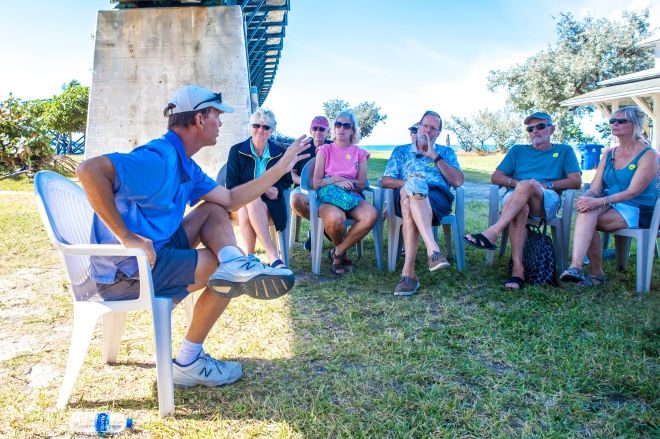 At Pigeon Key, tour guide, Eric, fills everyone in on the history of the tiny island. Although we went by dinghy, there is a small tour boat to transport visitors to the site. In the past, cars were able to drive to the park, but the bridge is now under repair and the only way to get there is by boat.
At Pigeon Key, tour guide, Eric, fills everyone in on the history of the tiny island. Although we went by dinghy, there is a small tour boat to transport visitors to the site. In the past, cars were able to drive to the park, but the bridge is now under repair and the only way to get there is by boat.
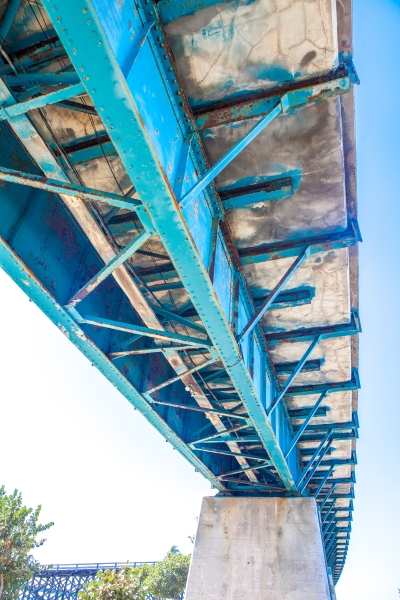 A section of the original railroad bridge
A section of the original railroad bridge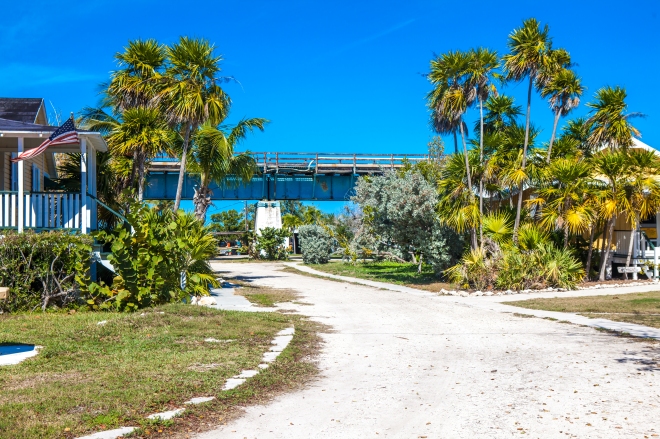 A view of the work camp where, at times, 400 men lived while working on the railroad.
A view of the work camp where, at times, 400 men lived while working on the railroad. One of the bridge painters homes, now a museum for the island.
One of the bridge painters homes, now a museum for the island. Looking through the ramp from the original bridge that led to Pigeon Key, you can see the old and new bridges together.
Looking through the ramp from the original bridge that led to Pigeon Key, you can see the old and new bridges together.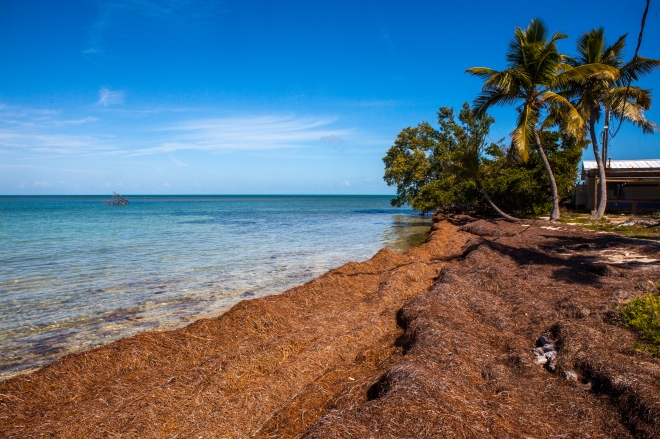
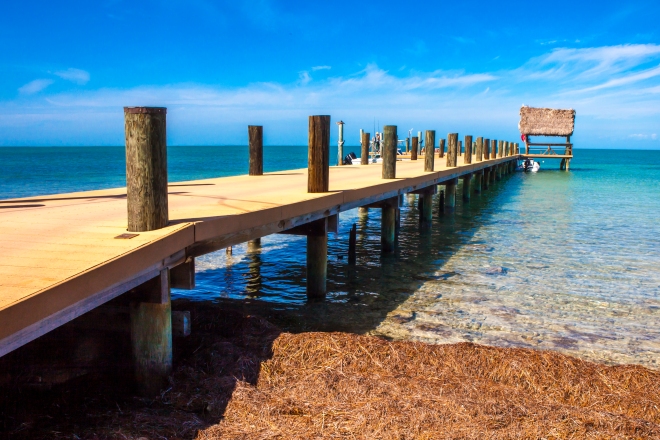 That’s our dinghy at the end of the dock.
That’s our dinghy at the end of the dock.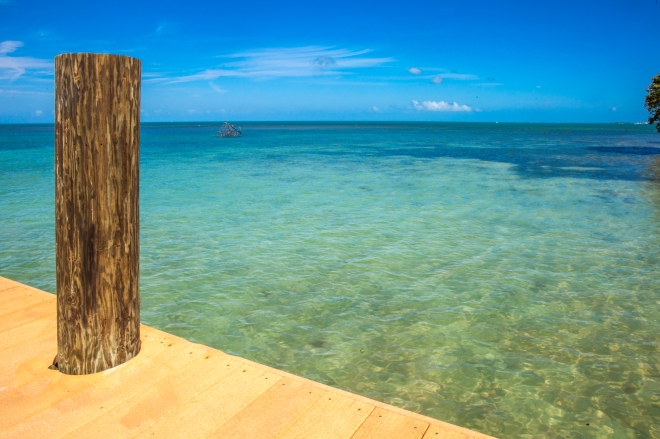
At first we planned to stay in the marina for a week, but, as Jason and Lisa were coming to visit, we thought two weeks would be better. Jason and Lisa love to fish and Marathon is known to be one of the best fishing areas in the world. Before they arrived we took the dinghy, one day, to Pigeon Key, located under the Seven Mile Bridge. Pigeon Key is a tiny island that was used by Flagler for a work camp for the workers building the railroad. Tours are given on the island, which is now used mainly as a science camp for middle and high-school students interested in marine sciences. John and I both found the tour to be fascinating and the excursion to be well worthwhile. Also, before our guests arrived, we were able to meet up with Lynn and Doug from DougOut again, as they had spent most of the winter in a nearby marina on Marathon.
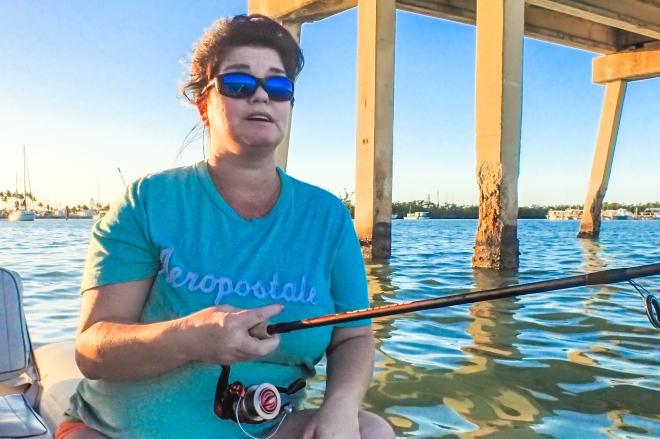 Out fishing in the Boot Key Harbor
Out fishing in the Boot Key Harbor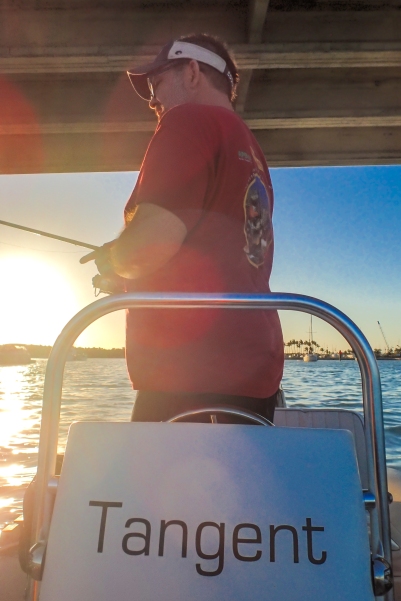

Soon it was time for Jason and Lisa to arrive. Luckily I was pretty well provisioned, thanks to Publix delivering groceries to the marina, but we made a quick trip to the store anyway to pick up last minute supplies. We weren’t back from shopping long before Jason, Lisa, and I headed out on the dinghy, Tangent, to do a little fishing in the harbor. I watched and they were both rewarded with catching some yellow tail snappers and some grunts that evening.
 A yellowtail snapper from under the Seven Mile Bridge
A yellowtail snapper from under the Seven Mile Bridge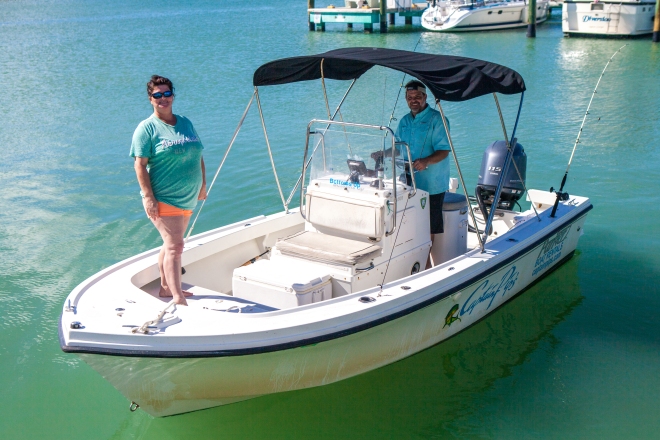 Jason’s rental boat for the day.
Jason’s rental boat for the day. This friendly manatee came to check us out near the dock at the marina/
This friendly manatee came to check us out near the dock at the marina/
The next day, Jason rented a fishing boat and he invited John and me along for the ride. It was a little rough so we hung out by the Seven Mile Bridge in the morning and all four of us were able to catch some fish and enjoy the fun. Jason was able to catch fewer fish than he might have because he was kept busy baiting our hooks and removing the catches we made. Around noon, John and I went back to the boat and Jason and Lisa went out again to see what they could catch. After returning back at AfterMath that afternoon, they cleaned the fish they caught and we enjoyed a delicious snack of yellowtail snapper, fresh from the sea.
Feeding the tarpon at Robbie’s
Before Jason and Lisa arrived, John and I had decided we would make a visit to Robbie’s, an eclectic spot on Islamorada, with them. We knew they would love to see the tarpon that hang out there waiting for a free handout from the tourists who come to feed these huge fish by hand. Also at Robbie’s is a great, rustic restaurant on the water and a sort of free for all collection of open-air shops to wander among. The day did not disappoint us; we all had a great time. Of course, after our return, more fishing occurred on the dock.
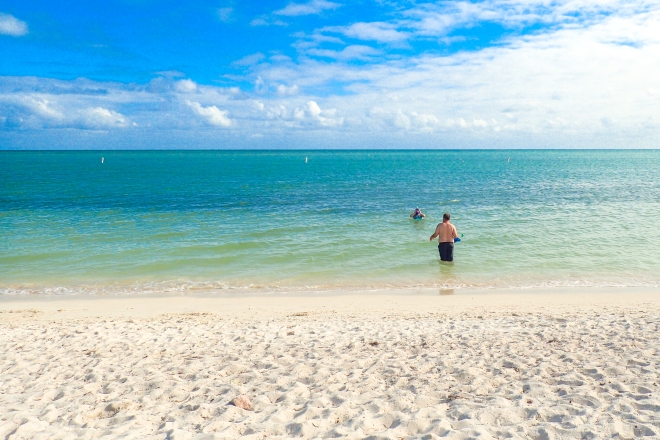 Sombrero Beach.
Sombrero Beach.  The pool at Marathon Marina
The pool at Marathon Marina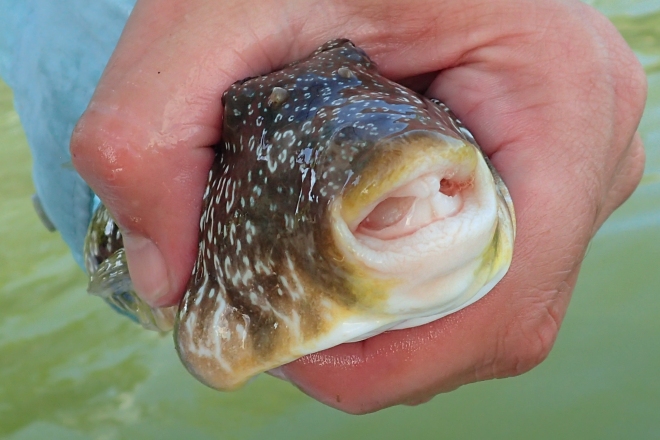 A puffer fish Jason caught near the mangroves
A puffer fish Jason caught near the mangroves A drone view of the marina. Drone pictures are courtesy of Jason.
A drone view of the marina. Drone pictures are courtesy of Jason.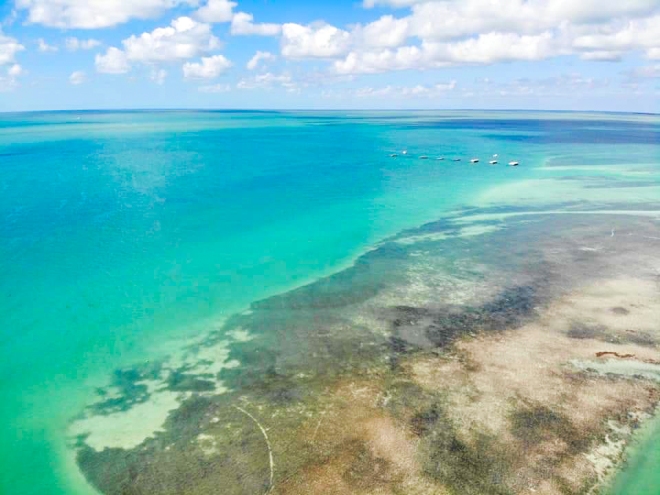
During their time with us, we also visited Sombrero Beach, Marathon’s most popular beach, spent time on Tangent fishing in Sister’s Creek amongst the mangroves, swam in the lovely pool at the marina, ate fresh lobster from a small stand along the road where you had to fish out your own lobster from the pool with a net, and enjoyed the pictures and videos Jason took from his drone. We had a great time and, of course, hated to see them leave.
 This and the following four pictures were the evolution of one night’s sunset. It was gorgeous.
This and the following four pictures were the evolution of one night’s sunset. It was gorgeous.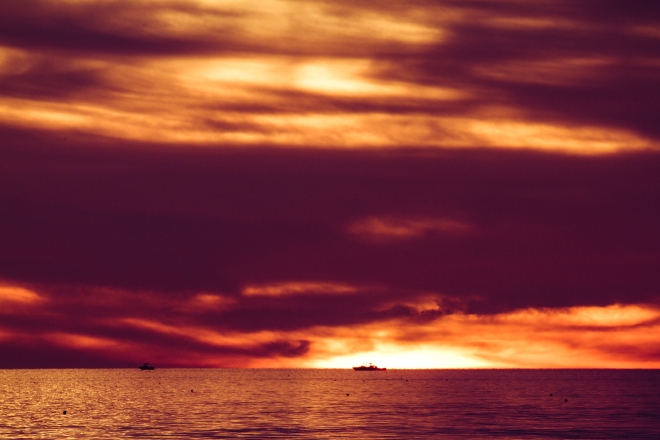


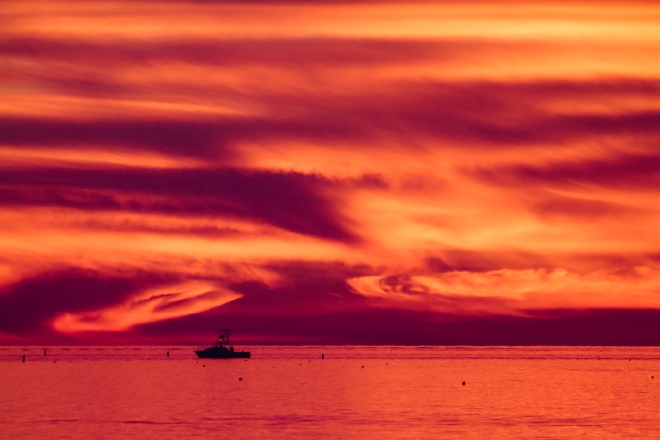
Two weeks somehow turned into three, but before we knew it, it was time to move along. While our original plan was to go to Key West from Marathon, we decided that, because we had been there quite a few times, both by boat and by car, and time was getting away from us, we would start heading north instead. So, on February 15th, we said goodbye to Marathon and started off to an anchorage not far from Robbie’s in Islamorada. We spent two nights there, enjoying being at anchor again, riding in Tangent to check out the sights, and watching spectacular sunsets before moving to our next stop, Key Largo.
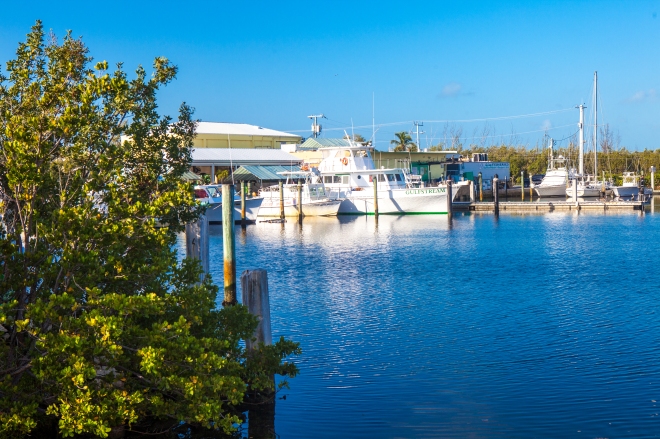 Looking towards the fish market in Key Largo
Looking towards the fish market in Key Largo
Motoring to the Pilot House Marina in Key Largo was an interesting experience. It seemed we must be going the wrong way as the canal going in was very small and traveled through a very residential neighborhood, but sure enough, at the end was a wonderful little marina and restaurant; next door was a great fish market, and stores were an easy walk away. We planned on staying only two nights, but weather and convenience changed our minds, and we stayed six instead. Preparations for our trip to the Bahamas had begun, so we rented a car to get whatever odds and ends we needed, oil for those every 150-hour oil changes and for provisions to fill the cabinets, freezer, and refrigerator.
 Leaving Pilot House Marina, Key Largo and heading to Miami
Leaving Pilot House Marina, Key Largo and heading to Miami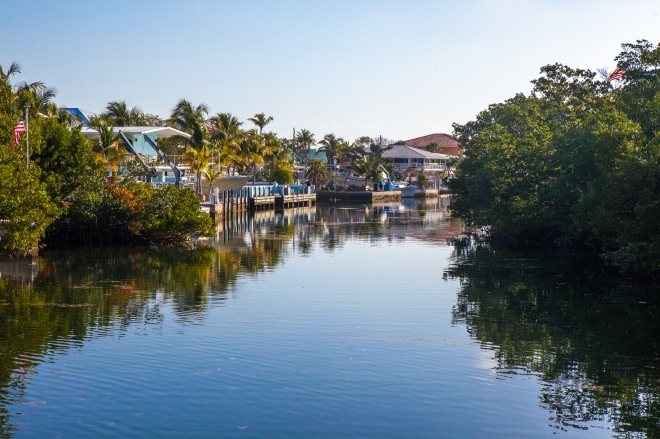

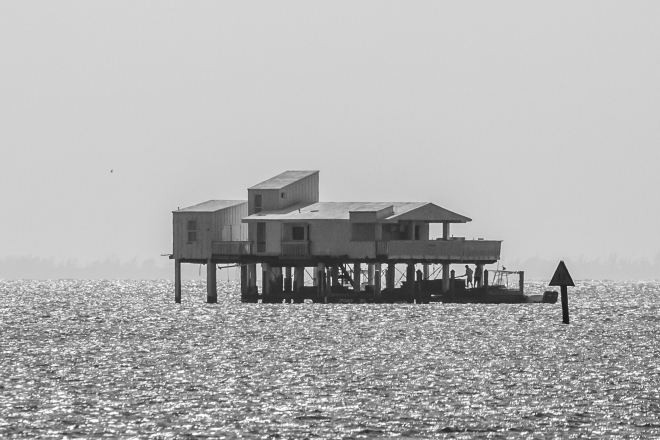 Seven structures, just off of Key Biscayne, were built in the early 1930’s and make up what is now known as Stiltsville. Originally there were 14 buildings, used as homes, drinking pubs during Prohibition, and even speakeasies. Now they have been taken over by the National Park Service.
Seven structures, just off of Key Biscayne, were built in the early 1930’s and make up what is now known as Stiltsville. Originally there were 14 buildings, used as homes, drinking pubs during Prohibition, and even speakeasies. Now they have been taken over by the National Park Service.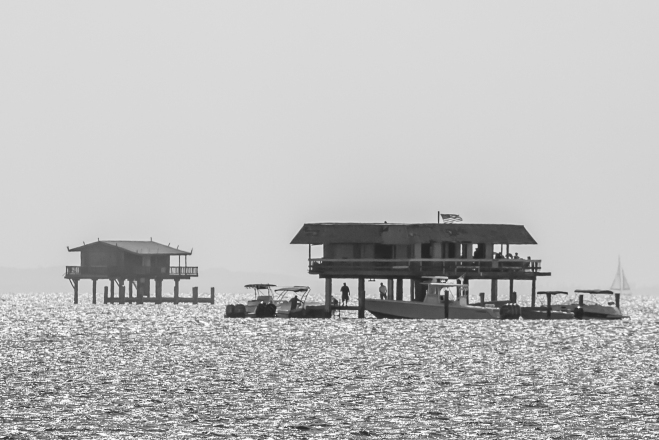

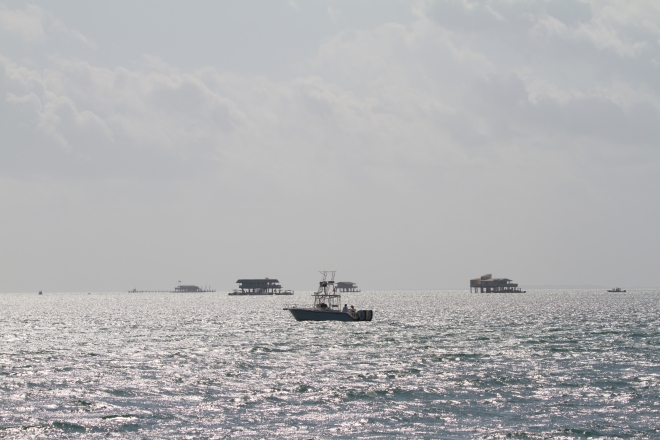
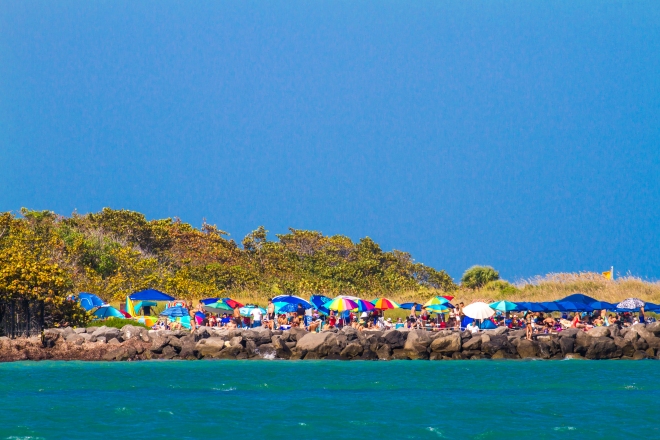 It was a busy day at Key Biscayne
It was a busy day at Key Biscayne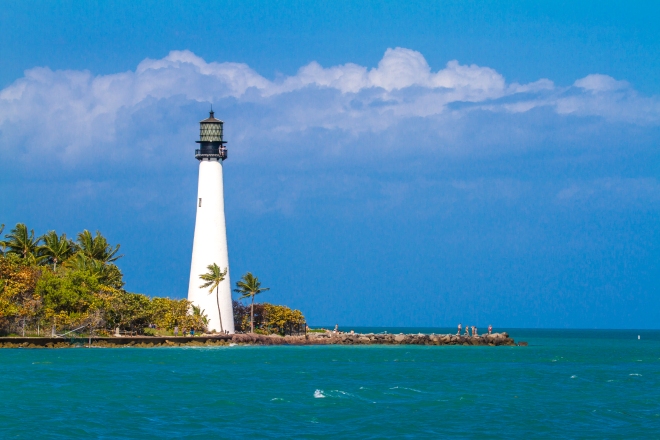
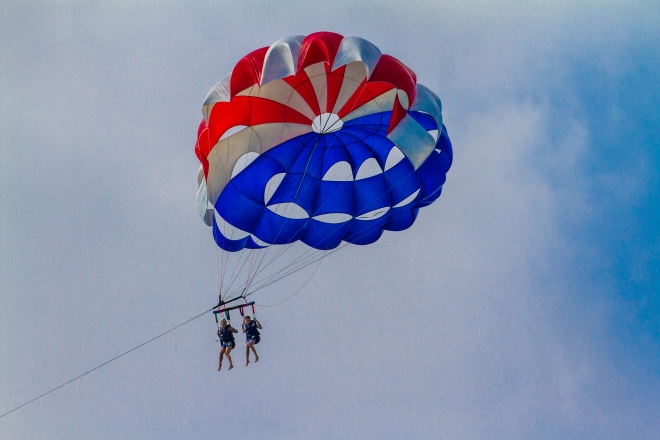
 As we entered Miami
As we entered Miami The golden hour before sunset in Miami
The golden hour before sunset in Miami
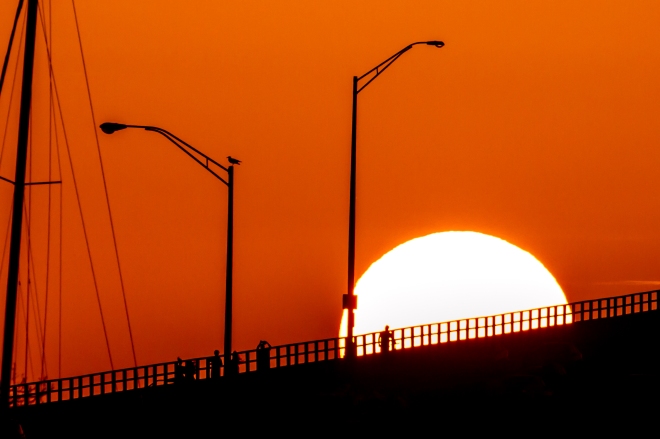
We had a nice weather day, yesterday, on February 24th, and motored to Miami, where we are at the present time. Our plans are changing by the minute, it seems, but right now we are anchored directly across from the city and right near the cruise ships waiting to set to sea. We will leave our anchorage tomorrow and as of this moment, I’m really not sure where we are going next! Wherever we go, we will be one step closer to the Abacos, where we expect to spend our Bahamian voyage. Who knows if our plan will stick, but, for this minute, on this day, that is what we imagine we will be doing for the next few months.
So, who knows where the next post will be from, but wherever we are, it will be the right place and the right time for us. We are getting closer to our adventure being over now; we have been on AfterMath for almost four years. When we return from the Bahamas, we will look for a place to live in Florida, but no specific area is in mind just yet. After all, if we have learned one thing through our time at sea, it is that plans are meant to be just that – a plan. And plans change.













Great posting. Love your stories and adventures. Safe voyages and enjoy the islands.
So Happy for you two.
L&Y
LikeLike
Thanks, Larry and Yvonne. You guys have been such great fans through this voyage! Miss you.
LikeLike
Thank you Debie, our hope is you chose Sarasota as your new home. I have loved your very articulate description of your travels. I am at anchor now off Spanish Wells⚓️ I’m not sure if you and John have visited this area but I believe you’d enjoy it..
Safe travels and smooth seas .. Doug Mashke
LikeLike
What a wonderful journey you have been on. Hard to believe, at least for me, that it will have been 4 years! Have so enjoyed your writings. Safe travels on to the Bahamas and back to your new home in Florida.
Gail
LikeLike
Oh my….what a fun blog to read and beautiful views! Love the sunsets and eclipse pics. Marathon looked like a wonderful place to spend some time with family. I spent a week in Marathon in January working with Habitat for Humanity on some disaster relief and had a wonderful time. My wife, Renee, and i met you guys at Joe Wheeler State park this past June; we were aboard ‘Aquaholic’ our Marinette. We love your boat name (particularly given that Renee is a Math teacher). Love reading your blogs. It gives us our ‘fix’ until we can get back onto our journey later this Spring/Summer.
LikeLike